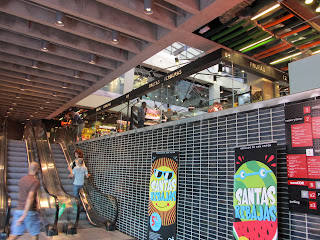Last Wednesday a few friends and I went down to the Matadero Madrid to see a show. The musician was Francesco Tristano, who was there participating in the Red Bull Music Academy (readers of Spanish, here’s a blog on the academy written by Abel Hernández, protagonist of El Hijo, a Spanish indie group that I like).
The first thing to be said is that the space was fantastic. The Matadero is the old public slaughterhouse of Madrid, now transformed into an open space for artistic creation, exhibitions, etc. [A phenomenon in some ways similar to the fascinating community arts/culture space that is La Tabacalera, the old tabacco factory, not far away.] The concert took place in the old nave. Imagine this with a stage in the middle and lots of lighting patterns playing off the architectural structure:
The slight eerie awareness that beef used to hang from those rafters was played off with a whimsical detail of two bulls and some music notes cut into a metal cube hanging over the stage.
Tristano’s music was a great fit for the setting. Comprised mainly of repetitive chords and rhythms on the piano, it started off as something like techno—but produced by a person, whose vitality (in contrast to the sterility of much of the techno you hear in discotecas around here) was visible in the movement of his body, practically dancing off the piano bench. Soon it was, indeed, bolstered by synthesizers and became a true hybrid of electronic and solo piano. But without the usual mind-numbing effect of techno.
Something that I often don’t like about electronic music is the sense of manipulation: it seems like beats are being accelerated and slowed to produce a certain reaction in me. Not so here. I was captivated by the music but I felt more intrigued than hypnotized. We were dissecting and penetrating into the possibilities of contemporary music—a great moment in the concert was when Tristano actually leaned into the grand piano to pluck the strings and drum on the lid. Here's the youtube video:
Throughout, the concert had me thinking about this use of repetition in music to create a new sense of awareness, to heighten the audience’s observation. The last song Tristano played involved several other musicians (a saxophonist, guitarist, and several dj’s at laptops) who were added one-by-one to create a symphonic effect. It reminded me a little of the sweeping arch of the first movement of Górecki’s 3rd Symphony—a piece that affected me in a similar way when I played it in college.
All in all, a fantastic experience. Can’t wait to get back to the Matadero and check out more there!























